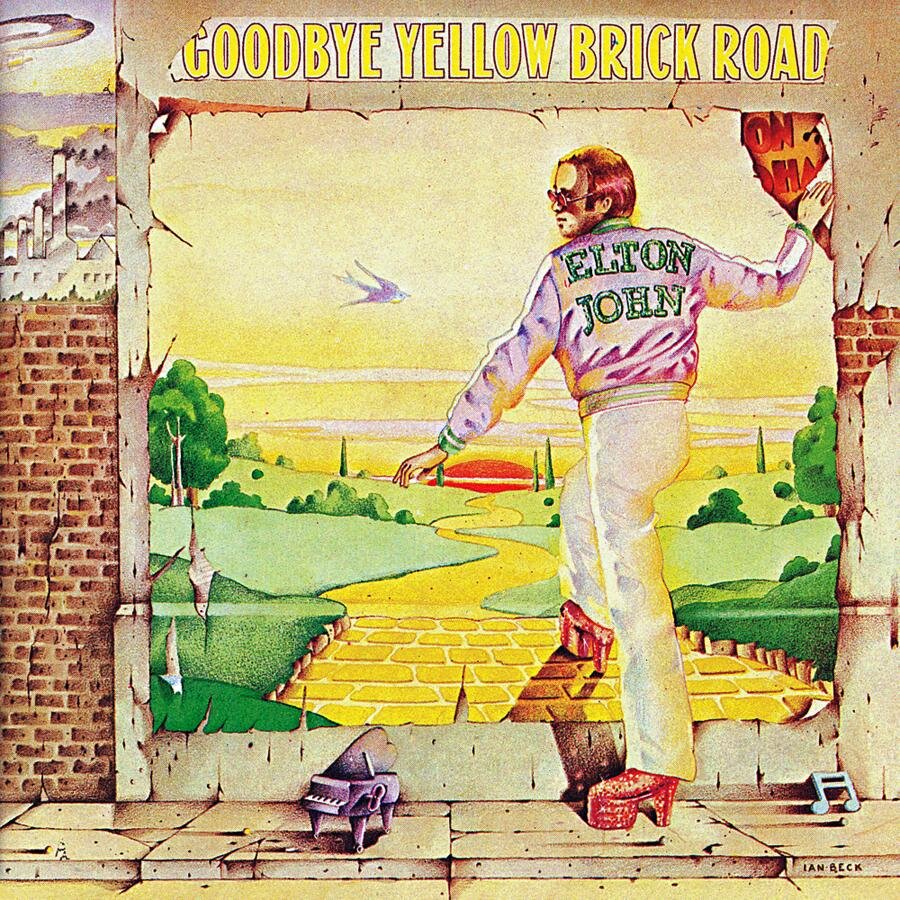Repaving a Yellow Brick Road

A look back at the glam roots of Elton John's "Goodbye Yellow Brick Road" 40 years later.
The 40th anniversary box set of Goodbye Yellow Brick Road includes “Elton John and Bernie Taupin Say Goodbye Norma Jean and Other Things,” a short documentary from 1973, the year of the album’s release. It’s fascinating in its hushed, mannered Britishness, full of powerful overstatement and reverence, but its era contextualizes all that. It’s fun in the way that fan-oriented artist biographies of the day are, but it inadvertently provides some insight. Watching Elton John, it’s remarkably easy to imagine him looking bookish in a cozy sweater and slacks. In conversation and onstage, clothes make the rock star, and he measured success not by how many people might hear his songs but by how many might record them.
When Stephen Davis first reviewed the album for Rolling Stone (generally negatively), he picked up on the album’s remoteness and its fascination with Hollywood nostalgia, whether it’s Marilyn Monroe and Roy Rogers or gangster movies and The Wizard of Oz. Taupin’s lyrics are often prematurely worldweary - the title track was ready to give up stardom before they’d really achieved it - and a little tough on women. Coming at the end of the ‘50s Revival, it has a few routine, overheated rock ’n’ roll numbers, but it also has the more convincing love letter to glitter rock, “Bennie and the Jets.” Is it a coincidence that illustration of “Bennie” on the sleeve looks a little like David Bowie circa Ziggy?
Goodbye Yellow Brick Road and Don’t Shoot Me I’m Only the Piano Player released earlier in 1973 highlight the relationship between the tweedy singer/songwriter (minus the songwriting) Elton John and the glam rocker who was friends with T. Rex’s Marc Bolan. He too modernized classic ‘50s rock ’n’ roll, though Bolan did so by running it through a Les Paul and a Marshall stack. “Saturday Night’s Alright for Fighting” may also be rooted in boogie woogie piano, but he and the band - particularly Davey Johnstone’s distorted guitar - give it a good glam makeover. Throughout, the healthy tension between Elton’s sensibility and his glam dreams proves productive, and as the live disc from 1973 included in the box shows, the band’s a surprisingly agile powerhouse. Drummer Nigel Olsson’s so behind the beat on the live “Bennie and the Jets” that the song’s in danger of falling over backwards, even as Johnstone plays a startling, morse code guitar solo on the outro. It was his third album with the core band that also included Dee Murray on bass, and it’s tempting to think that their chemistry factored into Elton’s writing.
Still, much of the album doesn’t work. When Susan Cowsill and friends performed the album, they correctly deemed “Jamaica Jerk-Off” too terrible to play, and there are a number of songs that work too hard going nowhere. The crazy prog instrumental “Funeral for a Friend” pays off with the energetic “Love Lies Bleeding,” but the synths throw bricks on the sinking, self-consciously writerly ship that is “This Song Has No Title.”
The accompanying book doesn’t allow that the album is anything but genius. Admittedly, it’s more of a scrapbook of periods photos, clippings and art, but the standards for writing in box sets are generally less fannish than this. Similarly, the inclusion of new covers of Goodbye Yellow Brick Road songs seems to be motivated by a desire to show the continuing relevance of the album, but only Miguel and John Grant transform the songs in contemporary ways (“Bennie and the Jets” and “Sweet Painted Lady” respectively). Country acts Hunter Hayes, The Band Perry and The Zac Brown Band produce pleasant but redundantly faithful versions; all they do is make me want to go back to the original.
When it was released, Goodbye Yellow Brick Road went a long way on ambition and ridiculously good singles. The era contextualized its weaker material, which today has no cover. Glam is as dated as the singer/songwriter pose, but after 40 years, the best material is still impressive and holds up not only over the years but through repeated listenings even now.






